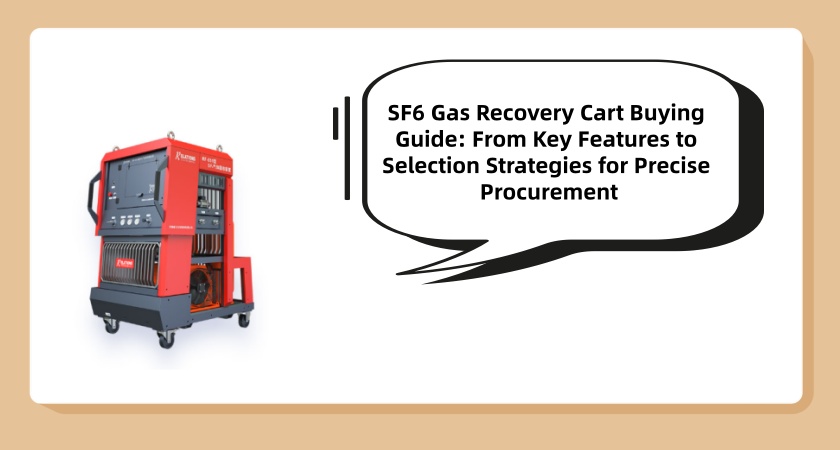
SF6 Gas Recovery Cart Buying Guide: From Key Features to Selection Strategies for Precise Procurement
Sulfur hexafluoride (SF6) gas is a core medium for high-voltage electrical equipment (such as GIS (Gas-Insulated Switchgear), transformers, and circuit breakers) due to its excellent insulation and arc-quenching properties. However, as a potent greenhouse gas with a global warming potential (GWP) 23,500 times that of CO₂, SF6 emissions are strictly regulated by global policies (e.g., the EU F-Gas Regulation and the U.S. EPA SNAP Policy). An SF6 gas recovery cart, as the core equipment for realizing the "recovery-purification-reuse" cycle of SF6, directly impacts an enterprise’s compliance, operational costs, and work safety. This article provides a practical procurement guide covering key features, application scenarios, and selection recommendations to help you make informed decisions.
I. Key Features of SF6 Gas Recovery Carts: 5 Core Procurement Criteria
A high-quality SF6 gas recovery cart must meet five core requirements: "high-efficiency recovery, deep purification, safety and reliability, scenario adaptability, and ease of operation." Its specific key features are as follows:
1. High Recovery and Purification Efficiency: Reduce Waste and Ensure Gas Reusability
2. Safety Protection: Avoid Leakage and Poisoning Risks
SF6 leaks can cause oxygen deficiency and asphyxiation, while its decomposition products (e.g., HF) are highly toxic. Therefore, safety features are non-negotiable:
3. Portability and Environmental Adaptability: Match On-Site Operation Needs
SF6 recovery is mostly carried out in scenarios such as substations and outdoor power plants, so the equipment must adapt to complex environments:
4. Intelligent Operation: Reduce Labor Costs and Misoperations
5. Compliance Certifications: Ensure Alignment with Global Regulations
Confirm that the recovery cart has obtained CE certification (for the EU market), EPA certification (for the U.S. market), or domestic CQC certification, and complies with local environmental regulations (e.g., China’s Technical Specification for SF6 Gas Recovery, Regeneration and Treatment (GB/T 37245)). This avoids penalties for non-compliant equipment.
II. Application Scenarios of SF6 Gas Recovery Carts: Match Models to Different Needs
Requirements for recovery carts vary significantly across industries and operation scenarios. It is essential to "select models based on needs":
| Application Scenario | Core Requirements | Recommended Cart Type |
|---|---|---|
| 1. Power company substations (GIS maintenance) | Frequent movement, small-to-medium capacity recovery (5–20 kg per recovery) | Portable recovery cart (weight ≤ 80 kg, pumping speed ≥ 30 m³/h) |
| 2. Power equipment manufacturers (factory testing) | High-precision purification, large-capacity storage (50–100 kg per recovery) | Fixed recovery cart (equipped with 100L gas storage tank, purification accuracy ≤ 10 ppm moisture) |
| 3. Industrial enterprises (captive power plants) | Dust resistance, wide temperature adaptability (frequent outdoor operations) | Explosion-proof recovery cart (IP54 protection, operating temperature: -15°C to 55°C) |
| 4. Third-party operation and maintenance companies (multi-client services) | Multi-functional adaptability (for equipment of different brands), data traceability | Intelligent recovery cart (supports multi-connector adaptation and data export) |
III. SF6 Gas Recovery Cart Selection Recommendations: 4 Steps to Avoid Pitfalls and Procure Precisely
1. Step 1: Clarify Your Core Needs (Avoid "Over-Procurement" or "Insufficient Functionality")
2. Step 2: Choose a Reliable Brand (Avoid "Three-No Products" – No Brand, No Certification, No After-Sales)
The market for SF6 recovery carts is mixed. Prioritize brands with over 10 years of industry experience and mature cases.
3. Step 3: Prioritize After-Sales Support (Avoid "No Guarantee After Purchase")
Consumables such as filters and seals in SF6 recovery carts need regular replacement, so after-sales service is crucial:
4. Step 4: Verify Equipment Performance (Avoid "False Parameter Labeling")
Before procurement, be sure to request an "on-site demonstration" or "sample trial," focusing on verifying the following:
IV. Conclusion
The procurement of SF6 gas recovery carts essentially balances "compliance, cost-effectiveness, and safety." The core principle is: Do not buy "low-spec models" for cheap (which may lead to penalties for non-compliance), nor blindly purchase "high-spec models" (to avoid functional waste). It is recommended to first clarify your needs, then select the most suitable model through three steps: "brand screening, after-sales evaluation, and performance verification." Ultimately, a high-quality SF6 recovery cart not only helps enterprises save SF6 procurement costs (saving 10,000 to 50,000 yuan annually on average) but also ensures compliance with environmental regulations, avoiding the risk of fines up to 1 million yuan.

Leave A Message
Your email address will not be published. Required fields are marked *